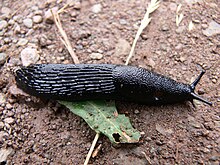| Black slug | |
|---|---|

| |
| A live and active individual of Arion ater | |
| Scientific classification | |
| Domain: | Eukaryota |
| Kingdom: | Animalia |
| Phylum: | Mollusca |
| Class: | Gastropoda |
| Order: | Stylommatophora |
| Family: | Arionidae |
| Genus: | Arion |
| Species: | A. ater
|
| Binomial name | |
| Arion ater | |
| Synonyms[1] | |
|
Limax ater Linnaeus, 1758 | |
The black slug (also known as black arion, European black slug, or large black slug), Arion ater, is a large terrestrial gastropod mollusk in the family Arionidae, the round back slugs. Many land slugs lack external shells, having a vestigial shell.[2] Most slugs retain a remnant of their shell, which is usually internalized,[3] unlike other terrestrial mollusks (such as snails) which have external shells. Without such shells, slugs produce mucus, that may also contain toxins—to deter predators. Terrestrial slugs produce two other forms of mucus that facilitate locomotion and prevent death from drying. Such mollusks are hermaphroditic. Slugs most often function as decomposers but are also often omnivores. Arion ater is one such slug, decomposing organic matter, preying on other organisms, and consuming vegetative matter including agricultural crops.[4] Native to Europe, the black slug is an invasive species in Australia, Canada (British Columbia, Newfoundland, Quebec), and the United States (Pacific Northwest, Alaska).
- ^ "Synonyms of Limax ater". AnimalBase, accessed 29 December 2010.
- ^ "Family summary for Arionidae". AnimalBase, last change 12-06-2009, accessed 23 May 2023.
- ^ Loest, R. A. (1979). "Ammonia Volatilization and Absorption by Terrestrial Gastropods_ a Comparison between Shelled and Shell-Less Species". Physiological Zoology. 52 (4): 461–469. doi:10.1086/physzool.52.4.30155937. JSTOR 30155937. S2CID 87142440.
- ^ Featherstone, Alan (2015). "European Black Slug (Arion ater)". Trees for Life.